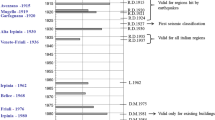Abstract
All over the world, the evaluation of seismic safety and providing retrofitting strategy for masonry buildings deserve basic attention. Therefore, improving building codes and expansion retrofitting methods a special effort is required. In Iran, a practical instruction for seismic rehabilitation of masonry schools has been published. The present instruction is developed to reduce earthquakes risk in only single-story masonry schools. To expand this instruction to two-story constructions that will be retrofitted mostly by shear walls, a comprehensive research has been conducted to estimate the seismic performance of existing two-story masonry schools. This extensive research program has seismic evaluated typical two-story Iranian masonry school. In this way, a three-dimensional finite element macro modelling technique has been developed using the Opensees software, in which the masonry panel and the reinforced concrete tie frame are modelled discretely. The effect of masonry walls in seismic capacity of structure and portion of new added shear walls has been investigated. Then the soil–structure interaction has been applied to provide foundation retrofitting method. In this study, evaluations had been obtained by nonlinear static and nonlinear dynamic analysis. The results of analysis show the Iranian two-story masonry schools have seismic vulnerability, and it is necessary improving building code for retrofitting of them. Finally, this study provides recommendations for retrofitting of two-story masonry building. The findings of this study can be used directly for the retrofitting programs of masonry buildings with similar conditions.









Similar content being viewed by others
References
Guideline No.10289/2-2266, Guideline Instruction for Seismic Rehabilitation of Masonry Schools (2011) International Institute of Earthquake Engineering and Seismology, Tehran, Iran
Yi T, Moon FL, Leon RT, Leon RT, Kahn LF (2006) Analyses of a two-story unreinforced masonry building. J Struct Eng 132(5):653–662. https://doi.org/10.1061/_ASCE_0733-9445_2006_132:5_653_
Gallonelli M (2007) Dynamic response of masonry buildings with rigid or flexible floors. In: Dissertation for the Master Degree in Earthquake Engineering, The University of Pavia Italy
Brandonisio G, Mele E, De Luca A, Montuori G (2013) Multi-storey masonry buildings: evaluation of effectiveness of mechanical strengthening. J Herit Conserv 33:7–14
Binici B, Aldemir A, Canbay E, Yakut A (2015) Lateral load testing of two existing masonry buildings. The word congress on advances in structural engineering and mechanics (ASEM15), Inchoen, Korea, August 25–29
Aldemir A, Binici B, Canbay E, Yakut A (2017) Lateral load testing of an existing two story masonry building up to near collapse. Bull Earthq Eng 15(8):3365–3383
Ruggieri S, Perrone D, Leone M, Uva G, Aiello MA (2020) A prioritization RVS methodology for the seismic risk assessment of RC school buildings. Int J Disaster Risk Reduct 15:101807
Chakra-Varthy P, Basu D (2021) Natural period and vertical distribution of base shear in confined masonry buildings using ambient vibration test. Bull Earthq Eng 19:1851–1899. https://doi.org/10.1007/s10518-021-01046-8
ParammalVatteri A, D’Ayala D (2021) Classification and seismic fragility assessment of confined masonry school buildings. Bull Earthq Eng 19:2213–2263. https://doi.org/10.1007/s10518-021-01061-9
Yekrangnia M, Bakhshi A, Ghannad MA, Panahi M (2021) Risk assessment of confined unreinforced masonry buildings based on FEMA P-58 methodology: a case study—school buildings in Tehran. Bull Earthq Eng 19:1079–1120. https://doi.org/10.1007/s10518-020-00990-1
Ruggieri S, Porco F, Uva G, Vamvatsikos D (2021) Two frugal options to assess class fragility and seismic safety for low-rise reinforced concrete school buildings in Southern Italy. Bull Earthq Eng 19:1415–1439
Ruggieri S, Chatzidaki A, Vamvatsikos D, Uva G (2022) Reduced-Order models for the seismic assessment of plan-irregular low-rise frame buildings. Earthq Eng Struct Dyn 51(14):3327–3346
Majedi M, Afrazi M, Fakhimi A (2021) A Micromechanical model for simulation of rock failure under high strain rate loading. Int J Civil Eng 19:501–515
Afrazi M, Lin Q, Fakhimi A (2022) Physical and numerical evaluation of mode II fracture of Quasi-Brittle materials. Int J Civil Eng 20:993–1007
Riazi E, Yazdani M, Afrazi M (2023) Numerical study of slip distribution at pre-existing crack in rock mass using extended finite element method (XFEM). Iran J Sci Technol Trans Civil Eng 47:2349–2363
FEMA 356 (2000) Prestandard and Commentary for The Seismic Rehabilitation of Buildings, Federal Emergency Management Agency, American Society of Civil Engineers, Reston, Virginia
GhaforyAshtiany M, Hatefi Ardekani H (2011) M6.5 Strong Ground Motion Data Base Scenario. In: Proceeding of IASPEI-IUGG 2011, Melbourne, Australia, June
Funding
We have no funding.
Author information
Authors and Affiliations
Corresponding author
Ethics declarations
Conflict of interest
We have no potential conflicts of interest (financial or non-financial).
Ethical approval
Research does not involve human participants and animals.
Informed consent
I understand that my manuscript and associated personal data will be shared with Research Square for the delivery of the author dashboard.
Rights and permissions
Springer Nature or its licensor (e.g. a society or other partner) holds exclusive rights to this article under a publishing agreement with the author(s) or other rightsholder(s); author self-archiving of the accepted manuscript version of this article is solely governed by the terms of such publishing agreement and applicable law.
About this article
Cite this article
Sartaji, P., Sarvghad Moghadam, A. Improving criteria for two-story confined masonry building retrofitted by shear wall. Innov. Infrastruct. Solut. 8, 323 (2023). https://doi.org/10.1007/s41062-023-01287-3
Received:
Accepted:
Published:
DOI: https://doi.org/10.1007/s41062-023-01287-3




